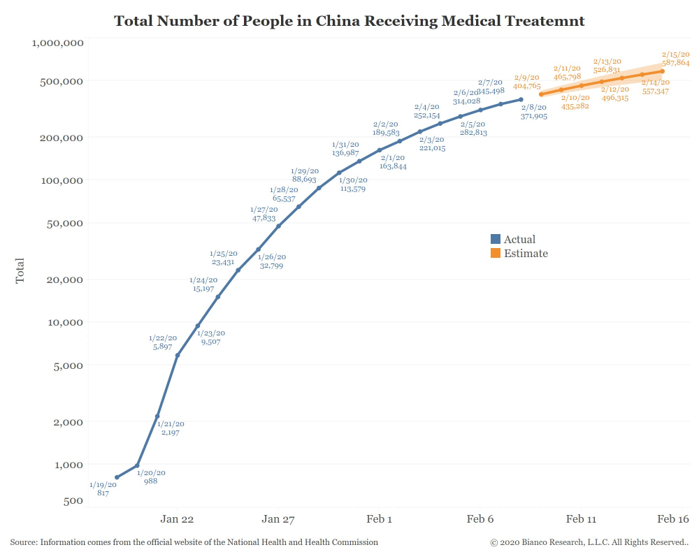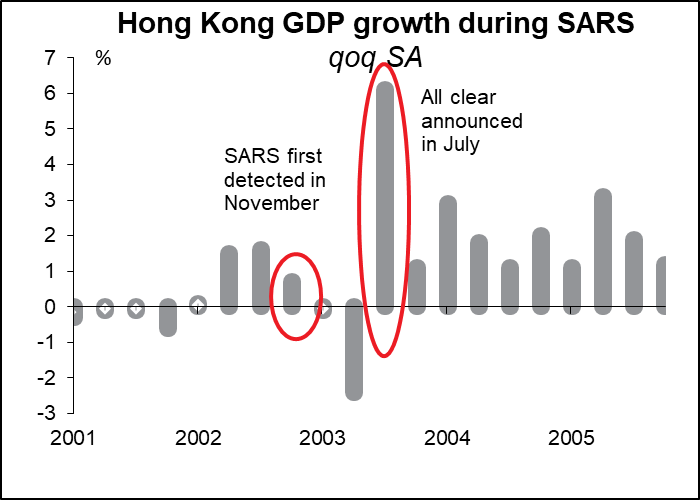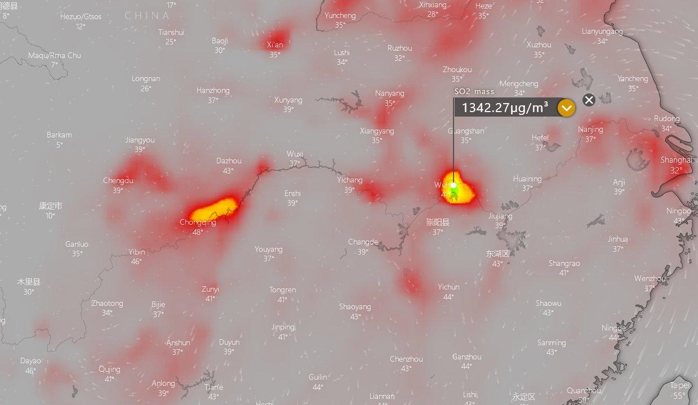I’ve avoided talking about the coronavirus much, because I’m an economist, not a doctor or epidemiologist. I prefer to talk about things I know about rather than speculating about fields other than my own. Nonetheless, I do read a lot, so I thought I’d put together some of what I’ve read and share it with my readers to save you the time and perhaps help your own research.
First off, this is enormous. China admits that some 350,000 people are receiving medical attention – the number may soon be over half a million. My question is, how many people did these half million infect before they got medical attention, during the period when the disease was asymptomatic but still communicable?

The graph below – from Trinh Nguyen, an economist at Natixis – is what really scares me. Notice the upward slope of the blue line, which is confirmed cases. This is exponential growth, which is exactly what you would expect – if each infected person infects two others, it’s going to grow by 2 X 2 X 2…, not 2 + 2 + 2 + 2. Eventually the virus either dies out through treatment and lack of transmission (we hope) or this line goes vertical.

Secondly, how deadly is it? According to Singapore PM Lee Hsien Loong:
The new coronavirus is similar to Sars, but with two important differences. First, the new virus is more infectious than Sars. Therefore it is harder to stop it from spreading. Second, the new virus is much less dangerous than Sars. About 10 per cent of those who caught Sars died. With the new virus, outside of Hubei province, the mortality rate is so far only 0.2 per cent. In comparison, seasonal influenza has a death rate of 0.1 per cent. So in terms of mortality, the new virus is much closer to influenza than Sars.
So while widespread, the virus does not seem to be that deadly – more than the flu, but nothing like SARS was. That’s good news.
(By the way, you should read that piece just to see how a real leader talks. The US used to have people like that, too. Used to.)
Third, will it be possible to stop it? According to a paper in the Journal of Travel Medicine, “Travelers Give Wings to Novel Coronavirus,”
Modelling results suggest that control measures would need to block more than 60% of transmission to control the outbreak. Based on observations with SARS and other infections, the basic reproductive may decrease as people become aware of the threat of infection and change behavior, but the basic reproductive number must drop below 1 to stop the epidemic. The analysis based on the model suggests there will be ongoing sustained transmission in the absence of effective interventions. (emphasis added)
(“Interventions” = a medical cure, which does not seem likely any time soon)
Until the virus is squashed, the impact on the global economy is going to be enormous, because much of China is on a virtual lockdown. For example, officials in part of Guangzhou have reportedly asked companies to delay restarting until March 1st (although those reports have not been verified). No production for a month = 1/12th or 8.3% of annual production. Moreover, several shipping carriers are no longer even accepting orders out of China.
The lockdown and isolation of China is going to affect factories globally, not just in China. Any company that has part of its supply chain – from raw materials to final assembly – involving China is in trouble. For example, Hyundai Motor has suspended most of its auto production in South Korea because the outbreak has disrupted the supply of parts. Similarly, Fiat Chrysler said one of its European plants might have to stop production in two weeks.
The impact on global growth depends on how quickly the virus can be stopped. The lesson of the SARS virus was that once the epidemic ended, economic activity rebounded immediately – the record highest qoq growth rate ever registered in Hong Kong remains the quarter when the “ all clear” was sounded from the SARS virus. In that case, the damage would be slight. However, we have no idea when that might be. Based on the reported growth rate as of late last week, the virus should burn out and activity return to normal by the end of April. In that case, the damage will be largely confined to China and Hong Kong, and the hit to world growth will be minimal.

One curious point: the Chinese government has ignored offers of help from the US Centers for Disease Control (CDC) and the UN’s World Health Organization (WHO). Why? Some people believe that the government was embarrassed during the SARS crisis and doesn’t want people to think it still needs help in dealing with such events.
Other people think it could be because the numbers are much worse than they’re admitting. As I mentioned previously, a Taiwan newspaper reported that the Chinese internet company Tencent may have accidentally released leaked real data on Wuhan virus deaths. Here are the numbers they flashed on the screen, only to remove them later. This picture shows the figures on 1 Feb compared to those on 2 Feb. Cases dropped to 1/10th the previous day’s level and deaths fell from 24,589 to 304! Were the numbers on the 1st wrong or were these people resurrected? Or maybe the numbers on the 2nd were false. We don’t know, but the Chinese government does not have a great history of transparency in such matters.

This map, from Intelwave, shows sulfur dioxide (SO2) releases from Wuhan and the nearby city of Chongquing, which is also suffering from the virus. SO2 is released by the burning of organic matter. It could be that this is from incinerating hazmat suits, sheets and other materials used to treat coronavirus patients. Or it could be coming from burning the bodies of victims of the disease. We don’t know. (Full disclosure: I went to the original source, www.windy.com, and tried to replicate this map. I didn’t get this high a concentration.)

Having said that, the Chinese government is taking extraordinary measures to deal with the outbreak. For example, they are fumigating the whole city with what look like snow-blowing trucks spewing water mixed with alcohol. Check out these videos: https://twitter.com/WLaowai8/status/1225809833837789186?s=20
https://twitter.com/Tssomas/status/1225809838963396608?s=20
There’s one other mystery surrounding the virus: while the virus is alleged to have originated in the Hunan Seafood Market, the Chinese government has not released any information on what animal specifically it came from. Moreover, it appears that no samples of animals were taken from the market, and the entire market was cleaned without any samples taken. This is like wiping down a crime scene without taking fingerprints or other evidence. Some people deduce from this fact, plus other aspects of the virus, that it may have come from a leak or mishandling of laboratory animals used in coronavirus studies at the Wuhan Institute of Virology. But this is just a rumor and in any case makes no difference, now that the horse has left the gate, so to speak.
To find out what it’s like on the ground, I strongly recommend this (heartbreaking) article from the Singapore Straits Times: Reporter’s Notebook: Life and death in a Wuhan coronavirus ICU It’s an interview with a doctor in Wuhan who is treating patients.
I’ve observed that the breakout period of the novel coronavirus tends to be three weeks, from the onset of symptoms to developing difficulties breathing. Basically going from mild to severe symptoms takes about a week. There are all sorts of mild symptoms: feebleness, shortness of breath, some people have fevers, some don’t…But some patients who enter the second week will suddenly get worse. At this stage, people should go to the hospital…. The third week determines whether critical illness leads to death….For most, the illness is over in two weeks, whereas for those for whom the illness becomes severe, if they can survive three weeks, they’re good. Those that can’t will die in three weeks.
His stories about patients turned away because of lack of hospital beds and about medical personnel working without protection because they know they’re already infected are heartbreaking.
Furthermore, don’t think you are safe because you don’t live in China. During the 2002/03 SARS epidemic, more than 8,000 persons in 37 countries were infected, with 774 dying. Back then there were only 17mn outbound Chinese tourists a year (including to Hong Kong and Macau). Now it’s some 180mn, or more than 10x as many. About 30,000 passengers fly from Wuhan daily, and of course the virus hit during the peak travel season for Chinese, right around the Lunar New Year. The virus has already been identified in 18 countries so far.
As I said, I’m an economist, not a doctor or epidemiologist. My former colleagues at Deutsche Bank did host a call last week with a genuine epidemiologist, who was much more optimistic than I am. He said the absolute number of new cases outside of China should peak, especially the number of locally acquired cases. And the rate of spread of the virus outside of China’s Wuhan province, which is on lockdown, should peak. The official statistics for both are apparently improving. You can keep track by watching the WHO’s daily situation reports.
Other official sources include WHO’s coronavirus home page; ProMed: International Society for Infectious Diseases; and the US Centers for Disease Control.
As for unofficial sites, Johns Hopkins University has a great site with a map of the outbreak and much data. You can see it here. Bloomberg has an excellent page, Mapping the Coronavirus Outbreak Across the World. I don’t know if they’re going to keep it updated.
If you use Twitter, I suggest you follow the following people for information on the virus: WuhanLaowai8 @WLaowai8 , a resident of Wuhan who is reporting on it; Simon Rabinovitch @S_Rabinovitch, The Economist’s correspondent in China; and Trinh Nguyen @Trinhnomics, an economist at Natixis. Jim Bianco @biancoresearch has been posting updated graphs frequently.
Finally, for some local color, there’s a British YouTuber living in Wuhan who posts updates occasionally. https://www.youtube.com/channel/UC_6UrRXYAEfd-4Y2Ky7QMVw














